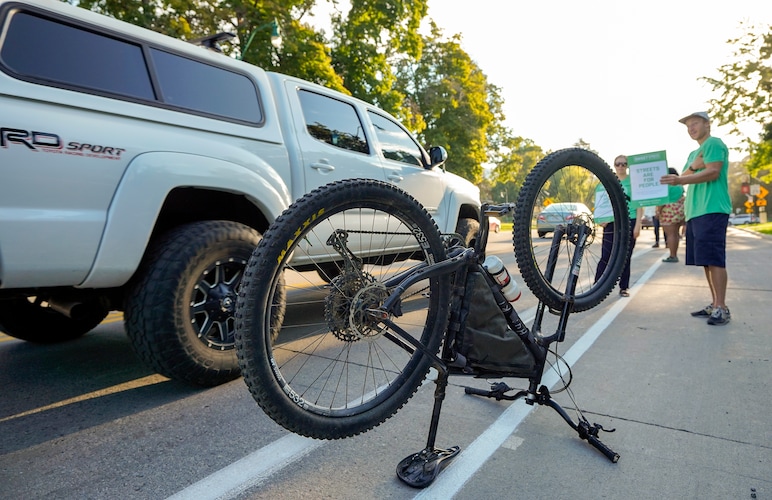Protesters lined a leafy block of Salt Lake City’s South Temple during Monday’s rush hour to form a “human-protected” bike lane, highlighting the need, they said, for more safeguards for cyclists across the city.
As commuting motorists whizzed by, about 10 members of the advocacy group Sweet Streets stood on the thin white lines of a newly painted bike lane along the busy thoroughfare, holding signs stating, “Streets Are for People.”
“I feel safer [biking] than I used to because of what the city has done,” Troy Saltiel, a member of Sweet Streets, said while standing at the traffic’s edge. Projects including the 9 Line Trail and the separated bike path on 300 West have encouraged Saltiel to start biking more, he said.

(Chris Samuels | The Salt Lake Tribune) Volunteers for the bike-safety advocacy group Sweet Streets form a human bike lane along South Temple Street in Salt Lake City, Monday, Sept. 9, 2024.
But he and other participants said they want the city to create more protected bike paths on streets such as South Temple, where the heavy flow of vehicles may discourage two-wheeled commuters headed to the University of Utah or downtown.
There are plans to make the city more friendly for those without vehicles. Salt Lake City’s Complete Streets ordinance requires that newly built or repaired roads “be designed, operated, and maintained for all modes of traffic, including people walking, biking and for travelers of all ages and abilities.”
“We’re seeing a lot more buffered bike lanes, which is good,” Saltiel said. But some streets such as 200 South, which was recently redesigned with new protected intersections and a dedicated bus lane, still do not include a protected bike lane.
“Ideally, you have protection everywhere,” Jon Larsen, Salt Lake City’s transportation division director, previously told The Salt Lake Tribune. But “there were some technical challenges” with the 200 South project.
(Francisco Kjolseth | The Salt Lake Tribune) A cyclist rides the 9-Line Trail along 900 South in Salt Lake City on Tuesday, July 9, 2024.
Last spring, Larsen said the city was prioritizing protected intersections, “because that’s where we see most of the issues.” About 27% of fatal bicycle deaths occur at intersections, according to the U.S. Centers for Disease Control and Prevention.
Last year, 14 people died in traffic-related injuries in Salt Lake City, according to a traffic violence map maintained by Sweet Streets. So far in 2024, four people have died.
(Chris Samuels | The Salt Lake Tribune) A commuter on a scooter rides past volunteers for the bike-safety advocacy group Sweet Streets aligned along South Temple Street in Salt Lake City, Monday, Sept. 9, 2024.
Sweet Streets Chair Benjamin Wood noted in a statement that that the city recently completed a “road diet” on the eastern portions of South Temple by converting some vehicle lanes into bike lanes. There’s still room for improvement, Wood said, “as there is currently nothing beyond a painted line to protect vulnerable road users from the threat of high-speed vehicles.”
Other streets west of 700 East, he said, have no dedicated space for cycling “and multiple lanes of through traffic create hazardous conditions for cyclists, pedestrians and transit riders.”
“Cycling provides incredible benefits to the community at large and to the individuals who choose to travel by bike,” Wood said. “But too often, city streets lack the safe, comfortable and inviting facilities that make cycling a legitimate alternative to driving.”
Wherever possible, he said, bike lanes should be protected by bollards, flexible signs, concrete curbs, landscaping or even parked cars.
“We can hardly expect residents to choose cycling over driving,” said Wood, “when doing so places them at risk of severe injury and death.”
In 2023, leaders in Utah’s capital also committed to adopting a “Vision Zero” plan to eliminate all traffic fatalities and serious injuries.
All these efforts — plus living in the Central City neighborhood — pushed Saltiel to ditch his car entirely, he said. As he held up his sign Monday with fellow protesters on South Temple, cars slowed and a few honked in support.
About two hours later, the protesters headed home and regular cyclists navigating South Temple once again had only a thin white line of paint to shield them from the vehicles zooming by.









